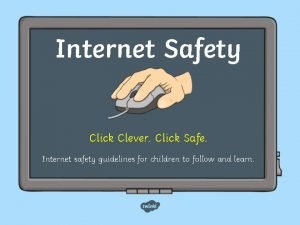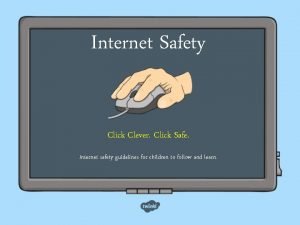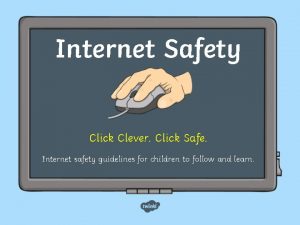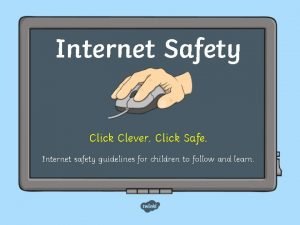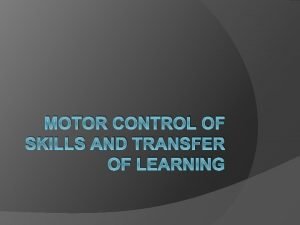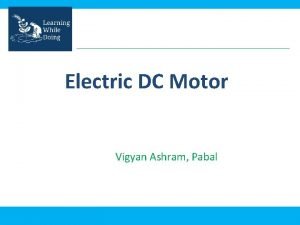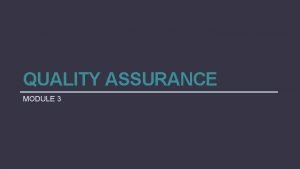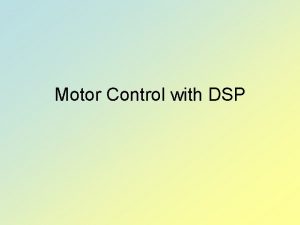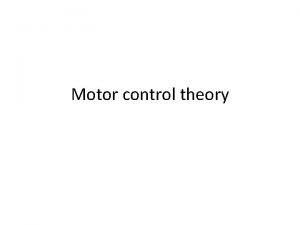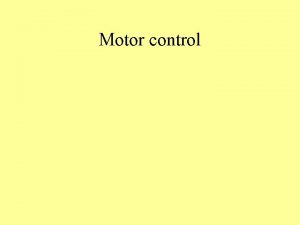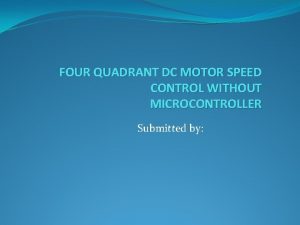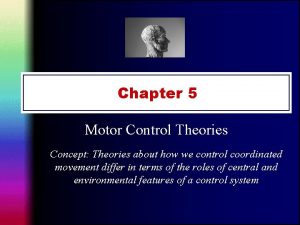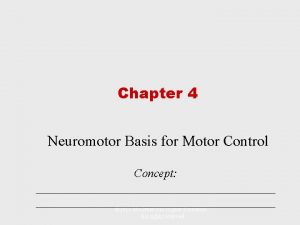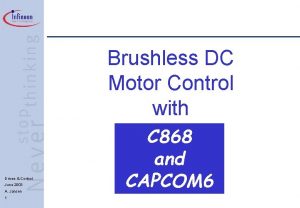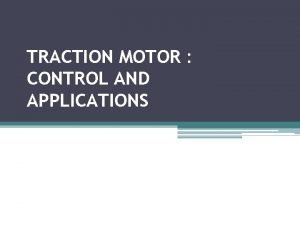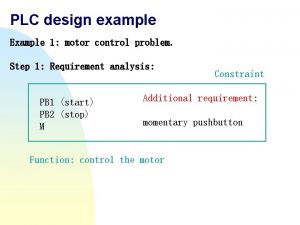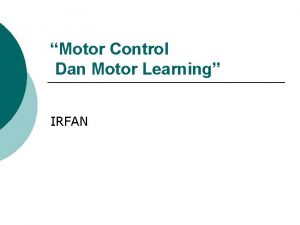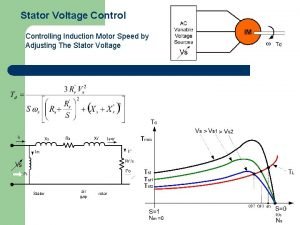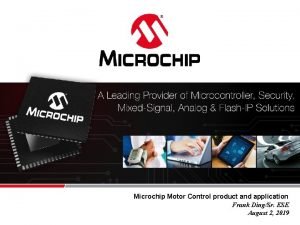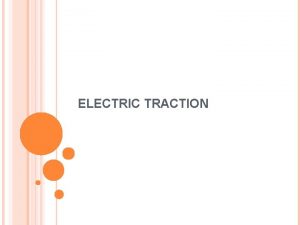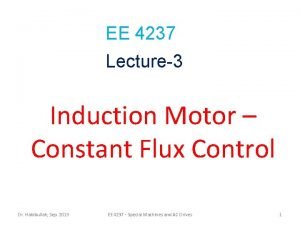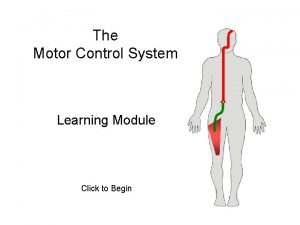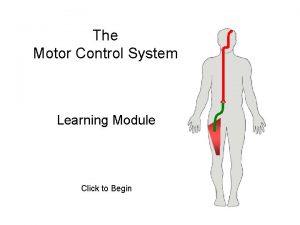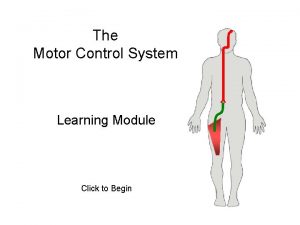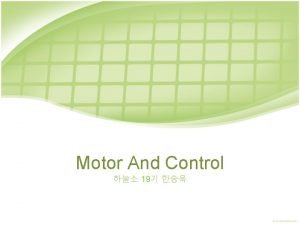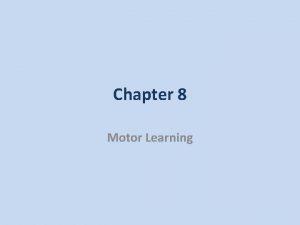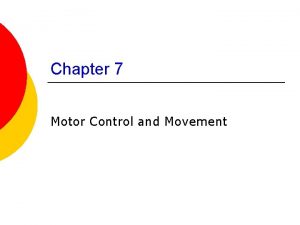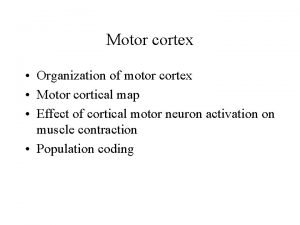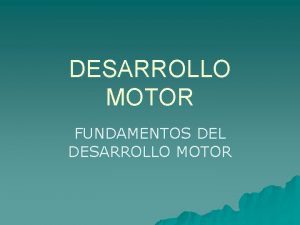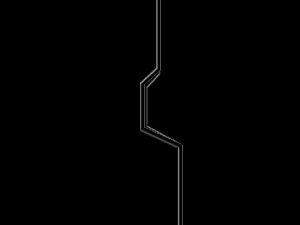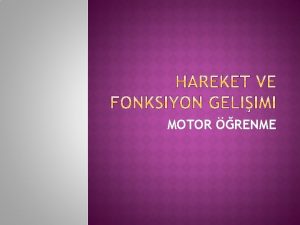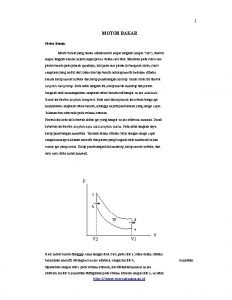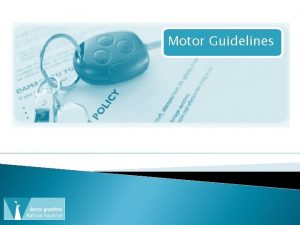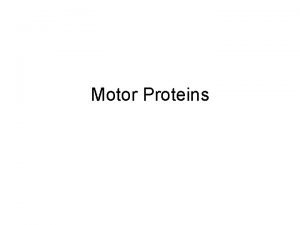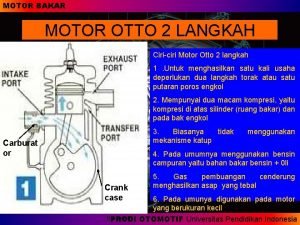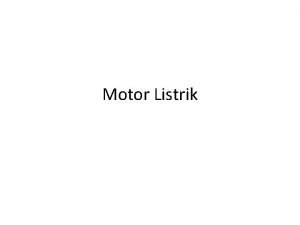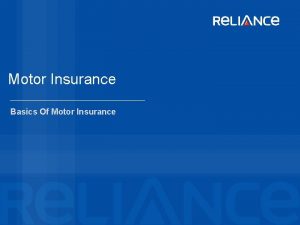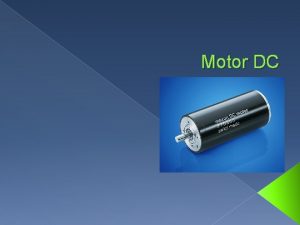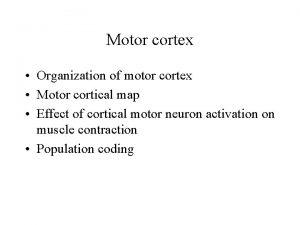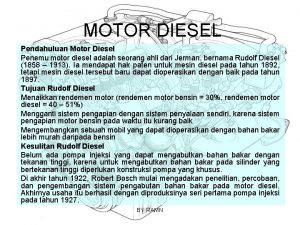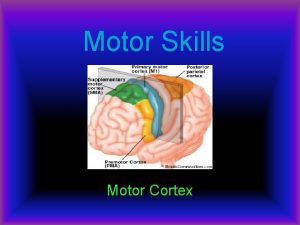The Motor Control System Learning Module Click to





























- Slides: 29

The Motor Control System Learning Module Click to Begin

Used with permission of the Academy of Neurologic Physical Therapy of the APTA Do not duplicate without acknowledging Learning Activity author Michael Mc. Keough, PT, Ed. D

Contents Overview Introduction Learning Objectives Instructions Legend Read these Instructions! Overview of the Motor Control System Lesion lessons Corticospinal tract lesion Lateral corticospinal tract lesion Ventral horn lesion Patient Cases Case 1 Case 2 Contents Lesions Patient

Overview Introduction Learning Objectives Instructions Legend Contents Lesions Patient

Introduction • This module reviews the Motor Control System. • Module organization consists of three components. Review of voluntary movement (knee extension as example), lesion lessons (3 interactive lesions with feedback), and patient cases (2 interactive cases with feedback). • At the bottom of each page, a navigation bar contains options to move throughout the module. • Material is presented at both the behavioral level and the neuroanatomical level. • The behavioral level is presented first and depicts a patient’s clinical presentation. • The neuroanatomical level depicts the detailed anatomy of upper and lower motor neurons. • The neuroanatomical level accounts for the patient’s behavioral presentation on examination under normal and lesioned conditions. Contents Lesions Patient

Learning Objectives After completing this module you should be able to: • describe, in detail, the structure and function of the corticospinal tract. • given a lesion, identify the signs and symptoms that would be expected. • given a patient case (examination results and chief complaint), identify the location of the lesion causing the signs and symptoms. • correlate neurology information between the behavioral and neuroanatomical levels. Contents Lesions Patient

Instructions • In addition to a description of normal motor control, this module contains 3 interactive lesion lessons with animation. • Lesson lessons begin with a question about the symptoms produced by that particular lesion. • Clicking the answer button will reveal the answer to the question. • Clicking the explanation button will lead to both behavioral and neuroanatomical explanations of the lesion. • neuroanatomical explanations are launched by clicking the animation button. The same button serves to replay the animation if desired. • Any of the lessons may be accessed by simply clicking on the lesion title on the Contents page. • Please refer to the Legend that defines the symbols used throughout the module. Contents Lesions Patient

Legend Mechanism of injury Upper motor neuron Lesion Lower motor neuron Stimulus Motor impairment Function intact Function lost Contents Lesions Patient

Voluntary Knee Extension: Behavioral Description Click to animate Voluntary movement is controlled by a system of brain and spinal motor centers linked by neuronal pathways. The primary motor pathway (Corticospinal tract) is crossed such that the left hemisphere controls movement of the right half of the body and vise versa. Motor pathways consist of upper and lower motor neurons. Upper motor neurons originate in the precentral gyrus, decussate in the medulla, descend in the lateral column of the spinal cord, and terminate on lower motor neurons in the ventral horn. Lower motor neurons exit the CNS and innervate skeletal muscles via the peripheral nervous system. Stimulus UMN LMN Neuroanatomical Explanation Contents Lesions Patient

Voluntary Knee Extension: Neuroanatomical Description The cell body of the upper motor neuron is located in he precentral gyrus (somatotopically organized). The axon descends through the internal capsule, decussates in the medulla, descends through the lateral column of the spinal cord and terminates in the ventral horn. The cell body of the lower motor neuron is located in the ventral horn. The axon exits the CNS via ventral rootlets of spinal nerves and innervates skeletal muscle via a peripheral nerve. Skeletal muscles contract to produce the force to extend the knee. Stimulus UMN LMN Behavioral Explanation Contents Lesions Patient

Voluntary Knee Extension: Neuroanatomical Description The cell body of the upper motor neuron is located in he precentral gyrus (somatotopically organized). The axon descends through the internal capsule, decussates in the medulla, descends through the lateral column of the spinal cord and terminates in the ventral horn. The cell body of the lower motor neuron is located in the ventral horn. The axon exits the CNS via spinal nerves and innervates skeletal muscle via a peripheral nerve. Skeletal muscles contract to produce the force to extend the knee. Behavioral Explanation Contents Stimulus UMN Lesions Patient

Lesion Lessons Corticospinal tract lesion Lateral corticospinal tract lesion Ventral horn lesion Contents Lesions Patient

Lesion of the left corticospinal tract (at the level of the cortex) produces what impairment? Click for answer Cortical damage to the left corticospinal tract causes upper motor neuron signs on the right face and body (arm, leg, and trunk, contralateral). Stroke is the most common cause of supraspinal damage to the corticospinal tract. Click for explanation Contents Lesions Patient

Corticospinal Tract Lesion: Behavioral Explanation Click to animate Damage to the corticospinal tract, prior to the decussation, produces UMN signs and symptoms to the contralateral face and body. UMN signs: • Weakness (Spastic paralysis) • Hyperreflexia (+ Babinski, clonus) • Hypertonia Lesion UMN Lost function Impairment Neuroanatomical Explanation Contents Lesions Patient

Corticospinal Tract Lesion: Neuroanatomical Explanation Click to animate Impairment is seen in the contralateral face because CN VII is crossed and the contralateral body because the UMN decussated in the medulla. Impairment is generalized to all body parts below the lesion level because the lateral corticospinal tract is an efferent pathway. Lesion UMN Lost function Impairment Behavioral Explanation Contents Lesions Patient

Lesion of the right lateral corticospinal tract produces what impairment? Click for answer Damage to the right lateral corticospinal tract causes UMN signs and symptoms in the right (ipsilateral) side of the body, generalized below the lesion level. Impairment is ipsilateral because the pathway decussated in the medulla. Impairment is generalized below the lesion level because it is an efferent pathway. The lateral corticospinal tract exists only at the level of the spinal cord. Click for explanation Contents Lesions Patient

Lateral Corticospinal Tract Lesion: Behavioral Explanation Click to animate Damage to the lateral corticospinal tract, after to the decussation, produces ipsilateral UMN signs and symptoms, generalized below the lesion level. Lesion UMN Lost function Impairment Neuroanatomical Explanation Contents Lesions Patient

Lateral Corticospinal Tract Lesion: Neuroanatomical Explanation Click to animate Because the lesion involves UMNs that have already decussated, impairment is ipsilateral to the lesion. Impairment is generalized to all body parts below the lesion level because the lateral corticospinal tract is an efferent pathway. Lesion UMN Lost function Impairment Behavioral Explanation Contents Lesions Patient

Lesion of the right ventral horn at L 2 -4 produces what impairment? Click for answer Lesion of the right ventral horn at L 2 -4 produces LMN signs (weakness and atrophy) of the right hip flexion, adduction, and knee extension muscles. Lesion of the ventral horn will damage the cell bodies of LMNs. L 2 -4 is the origin of femoral and obturator nerves which innervate the muscles of hip flexion, adduction, and knee extension. Because LMNs are uncrossed the impairment will be seen ipsilateral to the lesion. Click for explanation Contents Lesions Patient

Ventral Horn Lesion: Behavioral Explanation Click to animate Damage to the ventral horn produces ipsilateral LMN signs and symptoms, in a myotomal distribution. LMN signs: • • • Weakness (Flaccid paralysis) Hyporeflexia Hypotonia Atrophy Fasciculations Lesion UMN Lost function Impairment Neuroanatomical Explanation Contents Lesions Patient

Ventral Horn Lesion: Neuroanatomical Explanation Click to animate Damage to the ventral horn (cell body of LMNs) produces ipsilateral LMN signs and symptoms, in a myotomal distribution. Signs are ipsilateral because LMNs project to skeletal muscles via spinal and peripheral nerves that remain uncrossed. The distribution is myotomal because skeletal muscles are innervated by peripheral nerves that originate from selected levels of the spinal cord. Lesion UMN Lost function Impairment Behavioral Explanation Contents Lesions Patient

Patient Cases Read these instructions! Patient Case 1 Patient Case 2 Contents Lesions Patient

Case Instructions • These patient cases are intended to facilitate the integration and clinical application of information about lesions of the spinal cord by coupling the findings on examination and patient interview with their neuroanatomical correlates. • Each case begins with the patient’s chief complaint and significant examination findings. Then, the question is asked, Damage to what system(s) is causing this patient’s problems? Clicking the Answer button will reveal the answer and clicking the Show lesion button will reveal the neuroanatomic lesion along with the patient’s behavioral impairments. • Cases are presented from two perspectives. What lesion would account for a given set of examination results and patient history? For a given lesion, what signs and symptoms would be expected on examination? • Click on a case number to begin the exercise. Contents Lesions Patient

Review Questions: Case 1 In the emergency room the patient’s wife reports her husband had a sudden onset slurring of speech, inability to stand from a chair because of the inability to accept body weight onto his right leg, and the inability to feed himself or drink with his right hand. On examination the right side of his face was hypotonic, he was drooling from the drooping right corner of his mouth, and he had lost the nasal labial fold on the right. Damage to what system(s) is causing this patient’s problems? Answer Lesion of the left corticospinal tract above the level of the brainstem. Lesion of the left corticospinal tract, prior to the decussation (corticobulbar tract): removed cortical input to cranial nerves serving the face which are crossed (hypotonia and drooping of right face with drooling). Lesion of the left corticospinal tract, after the decussation: removal of cortical input to cervical (inability to feed himself or drink with his right hand) and lumbar regions of the cord (inability to stand from a chair because of the inability to accept body weight onto his right leg). Pathophysiology: stroke involving the perfusion territory of the left middle Show lesion cerebral artery (primary motor and sensory cortical areas). Contents Lesions Patient

Corticospinal Tract Lesion: Behavioral Explanation Click to animate Damage to the corticospinal tract, prior to the decussation, produces UMN signs and symptoms to the contralateral face and contralateral body. UMN signs: • Weakness (Spastic paralysis) • Hyperreflexia (+ Babinski, clonus) • Hypertonia Lesion UMN Lost function Impairment Neuroanatomical Explanation Contents Lesions Patient

Corticospinal Tract Lesion: Neuroanatomical Explanation Click to animate Impairment is seen in the contralateral face because the cranial nerves serving the face are crossed. Impairment is seen in the contralateral body because the UMN decussated in the medulla. Impairment is generalized to all body parts below the lesion level because the lateral corticospinal tract is an efferent pathway. Contents Lesion UMN Lost function Impairment Lesions Patient

Review Questions: Case 2 Imaging report: The CT image reveals a mass producing impingement of the lateral region of the right lateral column of the spinal cord at L 1. What signs and symptoms would be expected from this lesion? Answer A mass impinging the right lateral column at L 1 would affect the lateral corticospinal tract. The size of the mass will determine the extent of damage. The lesion will produce UMN signs in the right leg from L 1 down involving all leg muscles from the hip flexors down. If the lesion is complete, there will be paralysis. If the lesion is incomplete there will be paresis. In addition to weakness (paralysis or paresis), there will be hyperreflexia and hypertonia. Show lesion Contents Lesions Patient

Right Lateral Corticospinal Tract Lesion UMN Click to animate R L L 2 -4 Lateral corticospinal tract lesion Ipsilateral upper motor neurons signs generalized below the lesion level UMN signs Weakness (Spastic pa Hyperreflexia (+ Babin Hypertonia Common causes include penetrating injuries, lateral compression from tumors, and MS. Contents Lesions Patient

The End D. Michael Mc. Keough, PT, Ed. D 2015
 Safety click
Safety click Click clever click safe campaign
Click clever click safe campaign Click clever click safe
Click clever click safe Click clever click safe
Click clever click safe Open loop control motor learning
Open loop control motor learning Cuadro comparativo entre e-learning b-learning y m-learning
Cuadro comparativo entre e-learning b-learning y m-learning C device module module 1
C device module module 1 Pony motor starting method diagram
Pony motor starting method diagram The motor unit consists of
The motor unit consists of Application of synchronous motor
Application of synchronous motor Motor parts name
Motor parts name Pony motor starting synchronous motor
Pony motor starting synchronous motor Alternative learning system learning strands
Alternative learning system learning strands Quality assurance module
Quality assurance module Speed control of squirrel cage induction motor
Speed control of squirrel cage induction motor Dsp motor control
Dsp motor control Reflex theory of motor control
Reflex theory of motor control What is the importance of motor control
What is the importance of motor control Four quadrant dc motor speed control with microcontroller
Four quadrant dc motor speed control with microcontroller Schmidt's theory of motor control
Schmidt's theory of motor control Neuromotor basis for motor control
Neuromotor basis for motor control Bldc motor control theory
Bldc motor control theory Conclusion of traction
Conclusion of traction Identify the problem in this motor control plc program
Identify the problem in this motor control plc program Model informasi dari motor control
Model informasi dari motor control Stator voltage control of 3 phase induction motor
Stator voltage control of 3 phase induction motor Pic33ep512
Pic33ep512 Series parallel control of electric traction motor
Series parallel control of electric traction motor In ac motor control bi bi f is kept constant to
In ac motor control bi bi f is kept constant to Ac voltage controllers
Ac voltage controllers
